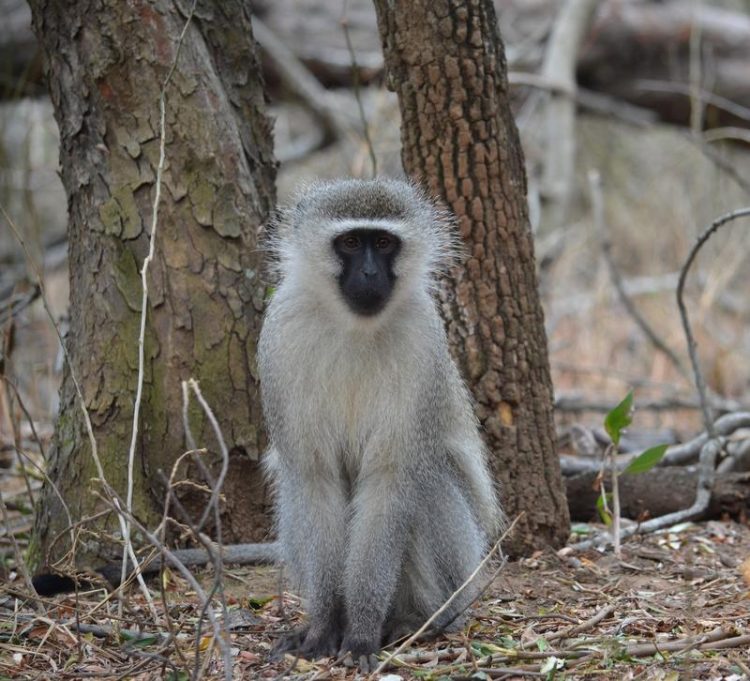Male Vervet Monkeys Use Punishment and Coercion to De-Escalate Costly Intergroup Fights

Male vervet monkeys use aggressive behavior against their own group members to inhibit them from fighting. Jean Arseneau-Robar, UZH
Social species engage in a number of cooperative activities including hunting, raising offspring, defending the group against predators, and fighting with neighboring groups. However, since social groups are collections of unique individuals, each member of the group obtains different benefits and experiences different costs when engaging in these cooperative activities.
As a result, group members may often disagree on when to cooperate, and when to defect. This is particularly true when it comes to intergroup fights, as participation carries a serious risk of injury or death, but winning can determine whether the group has access to important resources.
Punishment and coercion
While we know a great deal about how humans resolve such conflicts of interests, we know relatively little about the various mechanisms employed by other social species. A new study carried out by researchers of the University of Zurich shows that male vervet monkeys use punishment and coercion to de-escalate costly intergroup fights.
In particular, this strategy was used by males who were likely to have sired infants in the group, but were themselves wounded and so may have felt unable to defend their offspring should the need arise.
Aggressive behavior against combative group members
While conducting her doctoral research at the Inkawu Vervet Project in South Africa, Jean Arseneau-Robar, the first author of the study, observed males attacking their own group members during intergroup fights. “It has always been assumed that males exhibiting this behavior want to prevent females from mating with males in the opposing group. These acts of male aggression have thus always been interpreted as acts of mate defense,” says anthropologist Jean Arseneau-Robar.
However, the researchers noticed that male vervets usually did not attack female group members who were trying to affiliate or mate with males from the opposing group. Instead, males were more likely to direct aggression towards group members who were either trying to instigate a fight, or who had recently fought.
Females use “the carrot and the stick”
Erik Willems, who led the research, says: “We have recently shown that females in this species use both aggression as punishment and grooming as reward to manipulate the participation of male group members during intergroup fights.”
The researchers now wanted to know if males might similarly be trying to influence the outcome of intergroup fights. Indeed, they found that when males used aggressive behavior against their own group members, it effectively manipulated the behavior of their targets. However, male punishment and coercion inhibited group members from fighting, de-escalating the entire intergroup conflict.
De-escalation through punishment
UZH professor Carel van Schaik adds: “It was really interesting to see that while females use punishment and rewards to try and rally the troops, males actually use punishment and coercion to try and stifle the fighting, effectively keeping things calm and safe for small, vulnerable infants.”
Redouan Bshary, professor at the University of Neuchâtel, notes: “Usually, it’s the larger or more powerful individuals that punish the weaker ones. Our findings in the vervet monkeys are novel because here, both females and males are equally able to use this manipulative strategy. Importantly, females often form a coalition when punishing males, using strength in numbers to compensate for their smaller size.”
Literature:
Arseneau-Robar TJM, Müller E, Taucher AL, van Schaik CP, Bshary R und Willems EP. 2018. Male monkeys use punishment and coercion to de-escalate costly intergroup fights. Proceedings of the Royal Society B: Biological Sciences 20172323. DOI: 10.1098/rspb.2017.2323
Contacts:
Jean Arseneau-Robar, PhD / Erik Willems, PhD
Department of Anthropology
University of Zurich
Phone +41 44 635 54 01
E-mail: thelmajeanmarie.arseneau@uzh.ch / e.willems@uzh.ch
http://www.media.uzh.ch/en/Press-Releases/2018/Vervet-Monkeys.html
Media Contact
All latest news from the category: Life Sciences and Chemistry
Articles and reports from the Life Sciences and chemistry area deal with applied and basic research into modern biology, chemistry and human medicine.
Valuable information can be found on a range of life sciences fields including bacteriology, biochemistry, bionics, bioinformatics, biophysics, biotechnology, genetics, geobotany, human biology, marine biology, microbiology, molecular biology, cellular biology, zoology, bioinorganic chemistry, microchemistry and environmental chemistry.
Newest articles

First-of-its-kind study uses remote sensing to monitor plastic debris in rivers and lakes
Remote sensing creates a cost-effective solution to monitoring plastic pollution. A first-of-its-kind study from researchers at the University of Minnesota Twin Cities shows how remote sensing can help monitor and…

Laser-based artificial neuron mimics nerve cell functions at lightning speed
With a processing speed a billion times faster than nature, chip-based laser neuron could help advance AI tasks such as pattern recognition and sequence prediction. Researchers have developed a laser-based…

Optimising the processing of plastic waste
Just one look in the yellow bin reveals a colourful jumble of different types of plastic. However, the purer and more uniform plastic waste is, the easier it is to…



